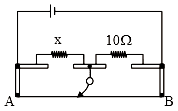A battery has e.m.f. 4 V and internal resistance r. When this battery is connected to an external resistance of 2 ohm, a current of 1 ampere flows in the circuit. How much current will flow if the terminals of the battery are connected directly?
1.
1 A
2.
2 A
3.
4 A
4.
Infinite
The current I as shown in the circuit will be:

1. 10 A
2.
3.
4.
A meter bridge is set up to determine unknown resistance x using a standard 10 resistor. The galvanometer shows the null point when the tapping key is at a 52 cm mark. End corrections are 1 cm and 2 cm respectively for end A and B. Then the value of x is:

1. 10.2
2. 10.6
3. 10.8
3. 11.1
The resistivity of iron is 1 × 10–7 ohm – m. The resistance of iron wire of particular length and thickness is 1 ohm. If the length and the diameter of wire both are doubled, then the resistivity in ohm – m will be :
(1) 1 × 10–7
(2) 2 × 10–7
(3) 4 × 10–7
(4) 8 × 10–7
The resistivity of a wire :
| 1. | Increases with the length of the wire |
| 2. | Decreases with the area of cross-section |
| 3. | Decreases with the length and increases with the cross-section of the wire |
| 4. | None of the above statement is correct |
Drift velocity vd varies with the intensity of electric field as per the relation:
1.
2.
3. vd = constant
4.
In a conductor 4 coulombs of charge flows for 2 seconds. The value of electric current will be :
(1) 4 volts
(2) 4 amperes
(3) 2 amperes
(4) 2 volts
The specific resistance of a wire is ρ, its volume is 3 m3 and its resistance is 3 ohms, then its length will be
(1)
(2)
(3)
(4)
When a piece of aluminum wire of finite length is drawn through a series of dies to reduce its diameter to half its original value, its resistance will become :
(1) Two times
(2) Four times
(3) Eight times
(4) Sixteen times
Through a semiconductor, an electric current is due to drift off:
(1) Free electrons
(2) Free electrons and holes
(3) Positive and negative ions
(4) Protons
